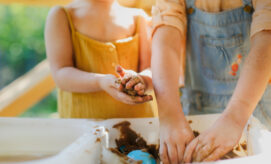Earth Day’s approach inspires thoughts and conversations about the environment and sustainability. These are great topics to introduce to the toddlers and preschoolers in your care. While this might seem like a big topic for young children, it is actually a great fit with their natural interest in nature, and with their enthusiasm for helping with chores. Conversations about how children’s actions can positively affect their environment help children feel empowered and capable.
In this article, we share some conversation-starters and activities that you can use to introduce the topic of sustainability into your classroom or program.
Starting the Conversation: Reduce, Reuse, Recycle
Introducing sustainability to young children can start with the simple saying: “Reduce, reuse, recycle.” Break down each word of the saying in kid-friendly language to help young children understand what they mean.
-
Reduce = “to use less,” such as when we’re washing our hands. We want to be careful about how long we let the water run!
-
Reuse = “to use again and again,” like our clothes. When we grow and our clothes get too small for us, we can give them to a friend or younger sibling who can use them again!
-
Recycle = “to make something new,” as we do with plastic bottles. Rather than throwing our water bottles in the trash, we can put them in the recycling bin so that they can be remade into new items, like new food and drink containers and even some types of clothes and toys!
Here are some free printables (scroll down until you see “Free Recycling Sort Printable”) that you can use to help children understand the difference between reducing, reusing, and recycling. When children understand that their actions impact the environment, they learn to be thoughtful about the materials they use and to feel good about helping keep their community healthy.
Ideas for Your Classroom or Program
Here are a few simple ways to incorporate learning about sustainability into your curriculum:
-
Model sustainable behavior. Young children tend to observe what we do and then follow our lead. We can show them how to practice sustainability by setting up recycling bins in the classroom and then demonstrating the way to place the right items in each bin. Sorting your classroom’s recycling by plastics, paper, and metal is also an opportunity for young children to practice early math skills. Separating items by material helps children to learn about categorization and pattern-matching.
-
Reuse materials in your classroom. Recycled items such as toilet paper rolls, cardboard scraps, bottle caps, empty jars, and more can all be reused in your classroom for art projects, milk jugs, loose parts, and more! Check your classroom recycling bin for materials that you might be able to reuse. This helps children to see how materials can be used in sustainable ways, rather than being thrown away after a single use.
-
Read books to children that demonstrate sustainability. Reading stories to children is always a great way to introduce them to new topics. Here are a few children’s books that explain or tell stories about sustainability:
-
Get outside! Spending time outdoors helps children to feel connected to the environment and to appreciate all that nature has to offer. While you’re playing outdoors, talk with children about the different plants and animals living in the environment around them. Recognizing that Earth is a shared space can inspire children’s interest in protecting nature.
-
Recycling trucks are fascinating! Young children love looking at the garbage and recycling trucks when they come to visit. Not only are these visits fun, but they also offer an engaging, real-time learning opportunity. As they watch the truck pick up items for recycling, talk with the children in your care about the recycling truck and how it takes our trash to be reused and made into new items.
Activity Ideas








